feature
Dinosaur Detectives
Introducing preschool students to modeling and paleontology
Science and Children—November/December 2020 (Volume 58, Issue 2)
By Laura B. Schneider and Angelique Kelly

Preschoolers are fascinated with dinosaurs, and they often have a wealth of knowledge about numerous dinosaur species. We capitalized on this interest by creating a three-dimensional 5E lesson (Engage, Explore, Explain, Elaborate, Evaluate; Bybee 2014) to introduce them to the science practice of modeling. Models are important as tools of reasoning that can be used to understand and explain parts of the world (Schwarz, Passmore, and Reiser 2017). In the Explore section of the lesson, students worked to “excavate” and put together physical model skeletons of dinosaurs. They used pictures and other resources to determine what parts of the skeleton were missing. For the Elaborate portion, they created their own model drawings of their ideas of what the dinosaur looked like when alive. We helped students write scientific claims and explain their reasoning for things like whether their dinosaur was bipedal or quadrupedal, what it ate, and special defensive features.
This lesson also introduced students to the core idea and crosscutting concept of structure and function through learning how the shape of an object can give us clues to how it was used. Students explored core ideas about common ancestry and diversity while learning about the discipline of paleontology. This relates to the lesson as students are comparing dinosaurs with living organisms and learning about how fossils help us infer the past.
Engage
Circle time discussion was used to formatively assess prior knowledge on fossils and paleontology. The circle area could be modified with stickers or colored tape markings where students could sit to safely social distance. Learners understood that bones could be fossils, but they did not know that footprints could also be fossils. Some of our students knew that shells and teeth could be fossils, and they explained that the museum was a good place to see fossils. They understood that scientists could study “old things,” but only two of them knew the word paleontologist.
The book Thomas the T. Rex: The Journey of a Young Dinosaur to Los Angeles introduced students to the field of paleontology and to fossils (Smith 2011). The young reader’s version of the book was selected since it is appropriate for this age group (www.eastwestdiscovery.com). Students listened for information about fossils and what a paleontologist does and raised a hand to share when they heard new information about that career. Students were asked to discuss how the photographs and illustrations related to the main ideas of the page (Common Core State Standards Initiative 2019).
The photos in the back of the book showed the actual team that excavated “Thomas.” Students were captivated by the photos and asked a lot of insightful questions like “if a T. Rex is the size of our classroom, how could they put it in the museum?” This led to additional discussions surrounding the length of time it took between finding the fossil and when it actually went on display in the museum, as well as discussion about excavating, shipping, and assembling the skeleton. One of our students told us, “I can’t wait until I am bigger so my job can be a paleontologist and I can find real fossils, too.”
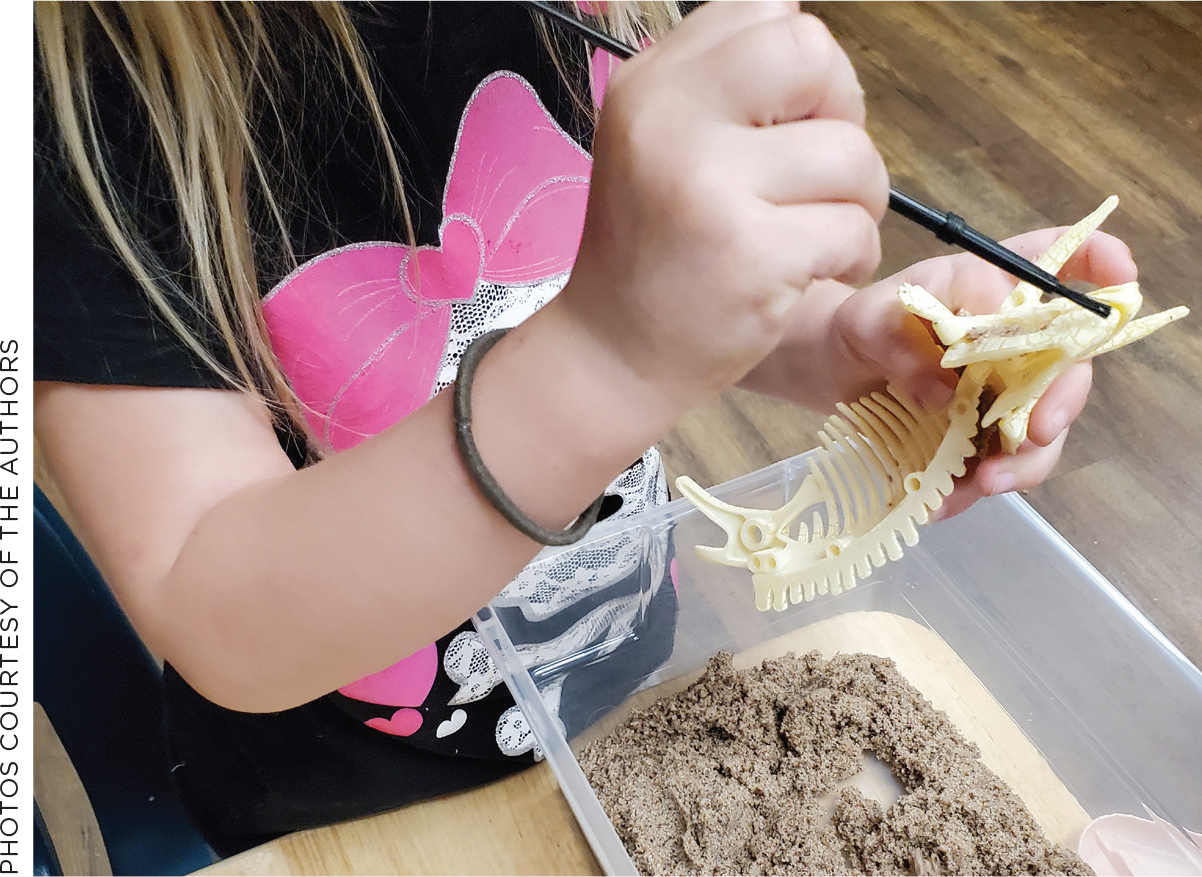
A student uses tools to clean uncovered bones. Photos courtesy of the authors.
Explore
We told students that they were going to be just like Thomas and Rita in the Thomas the T. Rex book and get to be “dino detectives” on a dig. The research question surrounding this inquiry is: If we study a dinosaur’s skeleton, what can we infer about it? If students have not been exposed to the vocabulary word inference, this is a good opportunity to learn a new word and skill. Students were divided into groups of two or three based on “flexible grouping” including interest level, special needs, and who would work best together in a cooperative scenario (Gumpert and McConnell 2019). Outdoor spaces could be utilized for having students work in groups or to facilitate easy sand clean-up. Follow all school guidelines regarding social distancing, sunscreen, bug spray, and hats. As a way to differentiate, learners who had accommodations and those who would need additional support were placed in one group at a table with a teacher sitting with them. This met the needs of learners by allowing for varying the pace of student work and helping students to think-pair-share during the activity after finding bones (Gumpert and McConnell 2019). The other teacher in the room worked with all of the other tables and still offered support.
Before having students go outside to work with their setups, we talked to them about safe materials use such as not poking each other with the paint brushes and excavating tools. This is also a great opportunity to introduce learners to the idea of scientists wearing safety gear. All students should wear googles when working with the excavating tools and sand products.
Each group was given a clear plastic shoebox with a plastic model of a dinosaur skeleton that had been covered with kinetic sand. We purposely made our own set-up in lieu of the premade kits where you excavate from a block of plaster since those involved too much hand strength for young learners and would not make the lesson reusable. Also, by burying our own fossil skeleton, we could remove one or two pieces from each skeleton. Doing so added a layer of authenticity, since it is rare to find a complete fossil skeleton. This also gave learners a chance to apply what they knew about bilateral symmetry by comparing their finds with living animals.
We chose kinetic sand because it was something we already had available and it made the activity one students could do multiple times. Kinetic sand can be purchased online for $10 for a 3 lb. bag. One bag was enough for two set-ups. An inexpensive alternative to kinetic sand would be to use wet playground sand or potting soil. The plastic dinosaur skeletons of triceratops, stegosaurus, and T. rex cost $5 each online. Students used small plastic scoops, wooden implements, and small paint brushes to excavate their finds. It was important that the implements were blunt for safety purposes. A second plastic box was provided for students to put their fossil bones into while working so they would not get lost. Students excitedly called out things like, “I found the skull,” “my dinosaur has big teeth,” or “This looks like a dinosaur leg” as they excavated their finds. After finding the bones, they were encouraged to compare their models with other groups and try to assemble the pieces together. As they made drawings of their finds, we encouraged students to add scientific labels to their drawing of words like ribcage, leg, and skull. Students got to practice using phonics to sound out words. We incorporated differentiation since there was a wide range of learners in the class and since some of them easily sound out words like “leg” and “foot” while other learners, especially younger ones, needed additional guidance in writing words. When students needed additional support, they would share what they wanted to write and we would either write out the word on a scrap of paper so they could copy it onto their paper, or we would use a colored highlighter to write the word on their paper so that the student could practice tracing the letters. It was important to give them encouragement and the appropriate level of support to help them to label their finds.
Explain
The class moved inside to our circle rug area to compare their skeletons with photographs of dinosaur skeletons the teachers had taken while visiting the Smithsonian Natural History Museum, as well as images from the Dinosaurs page of the American Museum of Natural History website (see Internet Resources). Students shared their drawings and discussed what they had found. We held up each plastic fossil skeleton and had students discuss what bones they saw and what they thought was missing. Students enthusiastically stated things like “its arm and hand are missing” or “I only found three dinosaur legs, but there should be four.” We encouraged the student to back their claim and explain their evidence. Students often cited things like knowing that other animals like alligators should have four legs.
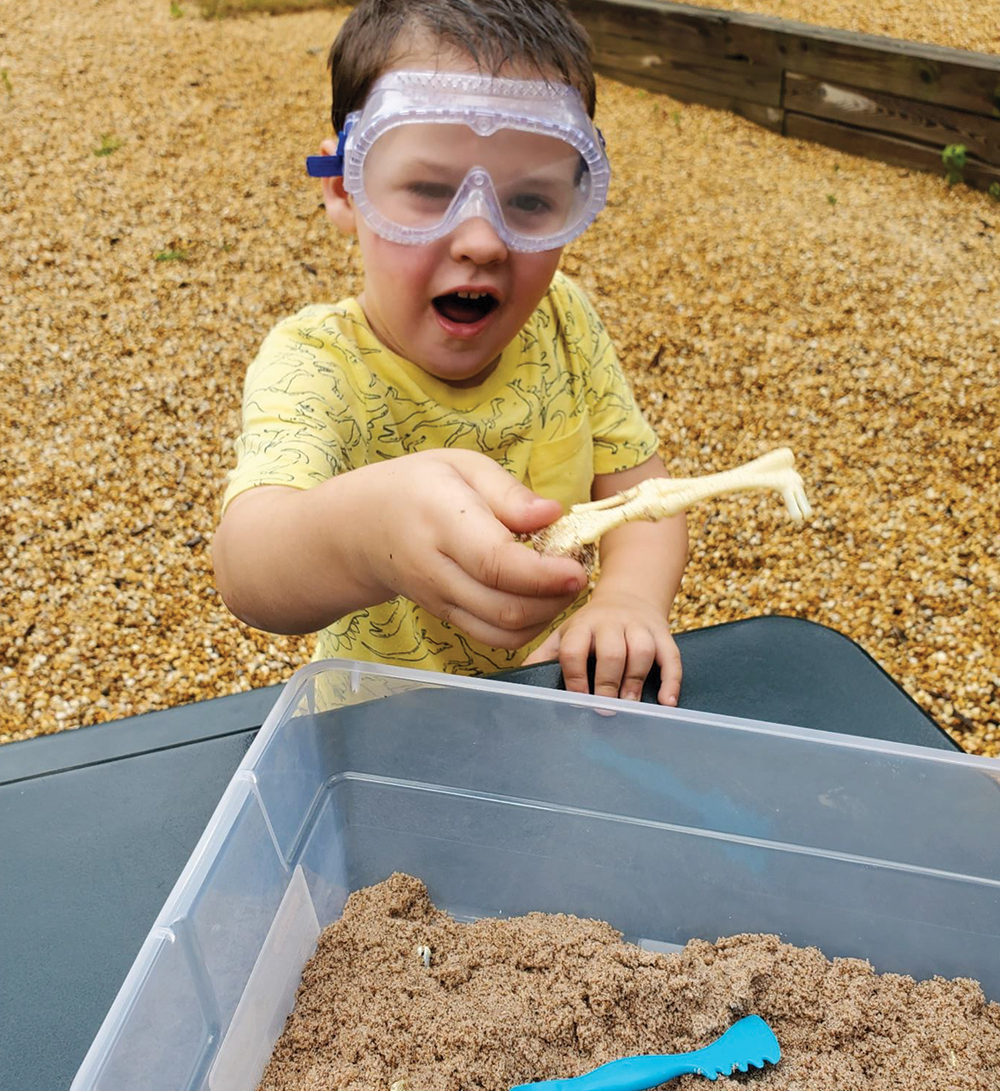
Sharing excitement at finding a dinosaur leg.
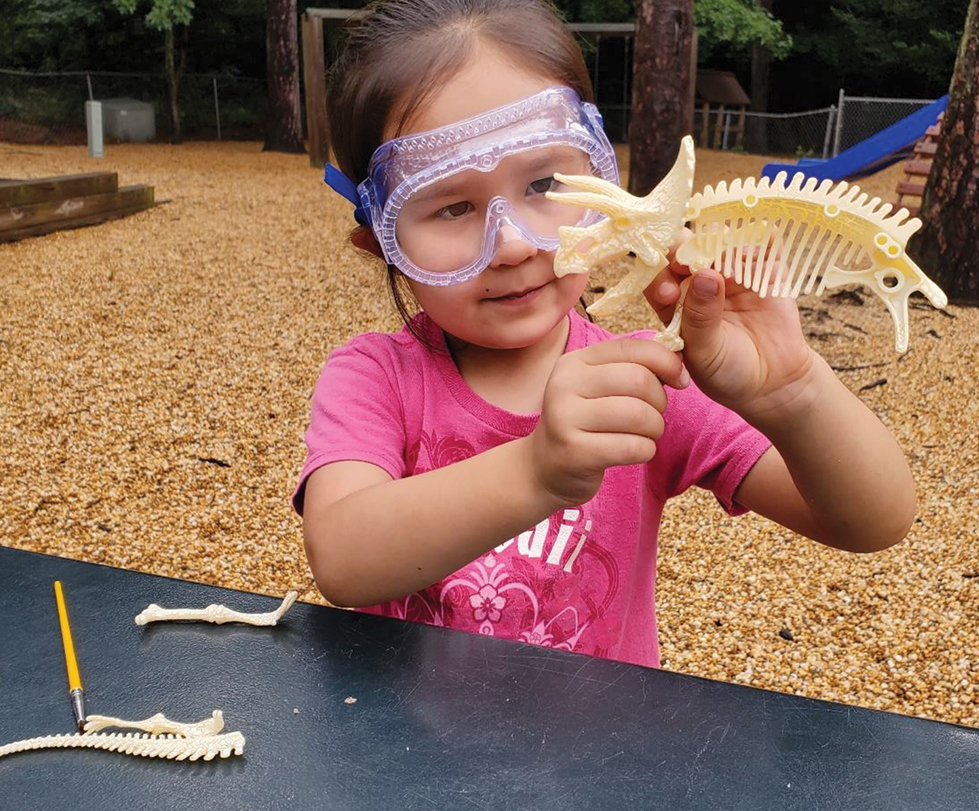
A learner articulates bones on her model.
Though we did not emphasize specifically having students use the words structure and function, we did introduce them to the terms and explained how the shape of an object relates to what it can do or why it is useful. We used the K–2 connection, “In grades K–2, students observe the shape and stability of structures of natural and designed objects are related to their function(s)” to guide our inquiry (NGSS Lead States 2013). Our students had a lot of prior knowledge about structure and function from everyday encounters with animals and a zoo field trip earlier in the year. We talked about special features that zoo animals had and what they could be used for. Students had recalled seeing giraffes using long necks to reach leaves and elephants using their trunks to give themselves dust baths. Students also talked about their own pets such as fish having fins to swim. We would have added additional support into the lesson like looking at pictures or watching clips on animals to relate ideas of structure and function if students had not had prior knowledge on the subject.
Pages 20–39 of the Eyewitness Book: Dinosaur were used to show structure and function of the tail, teeth, jaw, and special defensive features (Norman 2004). We explained how a paleontologist would use multiple pieces of evidence or clues to figure out what a fossil organism was like when alive. Students had a lot of questions about the pictures in the book and spent a long time discussing examples of carnivores and herbivores since they already had some knowledge on predator dinosaurs. Students were excited to share their background knowledge and talk about when a feature showed in the book reminded them of the dinosaur that they had just excavated.
Elaborate
We discussed how scientists use models to explain things, and that some models are used when things are hard to observe. One example was using plastic models of dinosaur bones because real dinosaur bones would be too big and rare to have in the classroom. We then looked around the rooms for examples of models which we said could be objects or pictures. Students were asked to look for science objects and manipulatives they thought could be used as models and once they said they found one, they were encouraged to bring it to the front of the class and explain why they thought it was a model. By seeing and touching models, it helped them better visualize examples of models. Getting to hold a manipulative also added differentiation while helping to make this big concept more real (Gumpert and McConnell 2019). An example that students gave was the globe is a model of the Earth. We also had a picture in the class of a frog life cycle, and we talked about how a picture could be a model and this particular model explained how the life cycle of that animal worked.
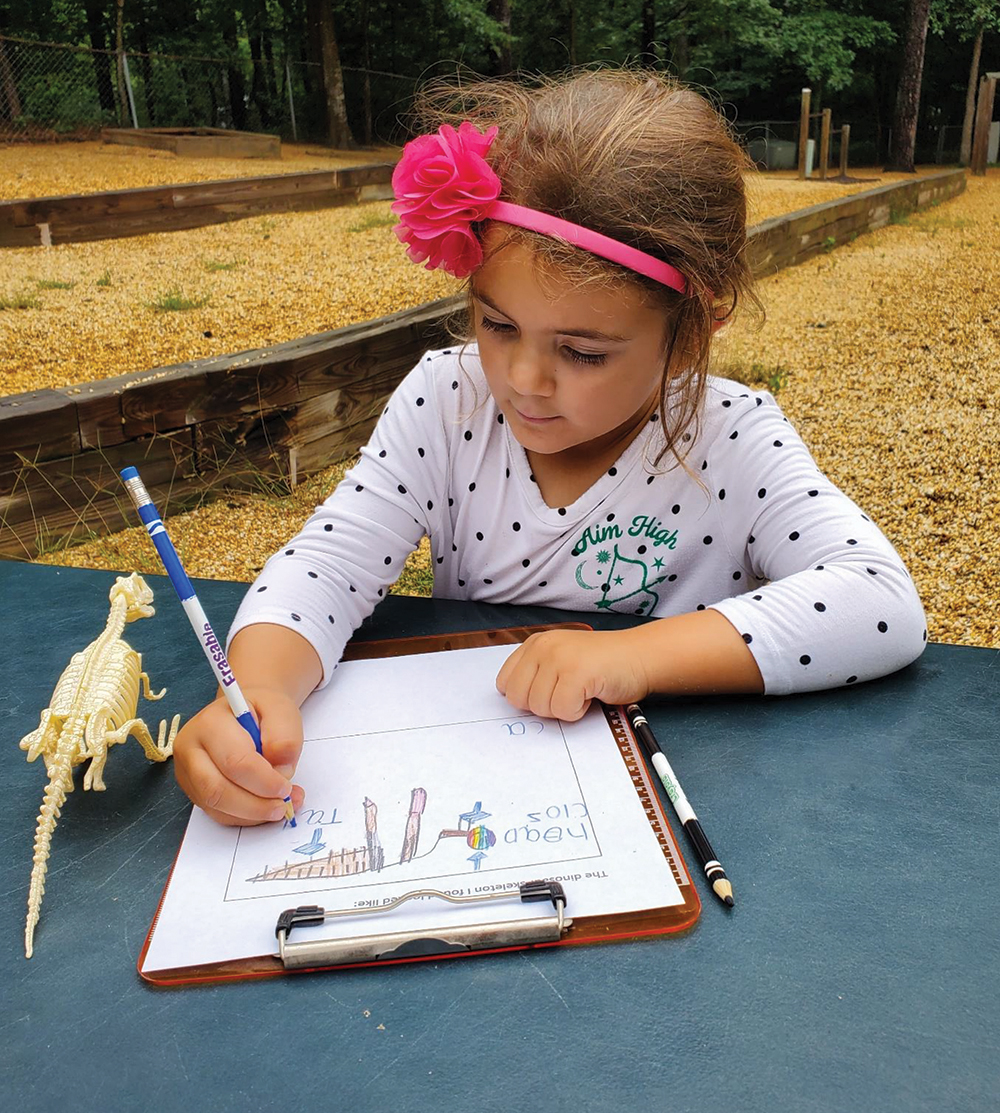
A student works to label her model drawing.
We then reiterated our research question: if we study a dinosaur’s bones, what can we infer about it? We also reminded students of what an inference is. We then challenged students to make model drawings using the supplies of their choice such as colored pencils, crayons, or markers. This could be done as an indoor or outdoor activity. If students are trying to write outside, having a clipboards makes it easier. We asked them to think about the skeleton they excavated and draw what they think their dinosaur would have looked like when it was alive. However, this could also easily be modified to differentiate the lesson product through adding “multiple means of expression” such as giving students “open-ended media” to produce their model such as clay, cardboard, or other recycled materials that they could use to create a model representation (Donegan-Ritter and Fitzgerald 2017).
Students could use books and pictures of dinosaurs as resources. Since all of our students were still learning to write words, we went around to each group individually to help students make claims about their dinosaurs using sentence starters and then back their claims with evidence. Sentence starters were important because it helped them focus their ideas and then get to make their own claims that reflected their learning. We used similar strategies as in the Explore section to help them write their words. It is very important that students have the opportunity to have their inferences written down to match their drawing. We guided learners to think about how facial structure could be used to infer diet, bone structure of legs to infer if a species was bipedal or quadrupedal, and how special structures could be for predation or defense. Students explained things like how the triceratops, “walked on four legs because all legs were big.” They also understood mouth structure being indicative of diet and told us the “tyrannosaurus eats meat because of the big pointy teeth.”
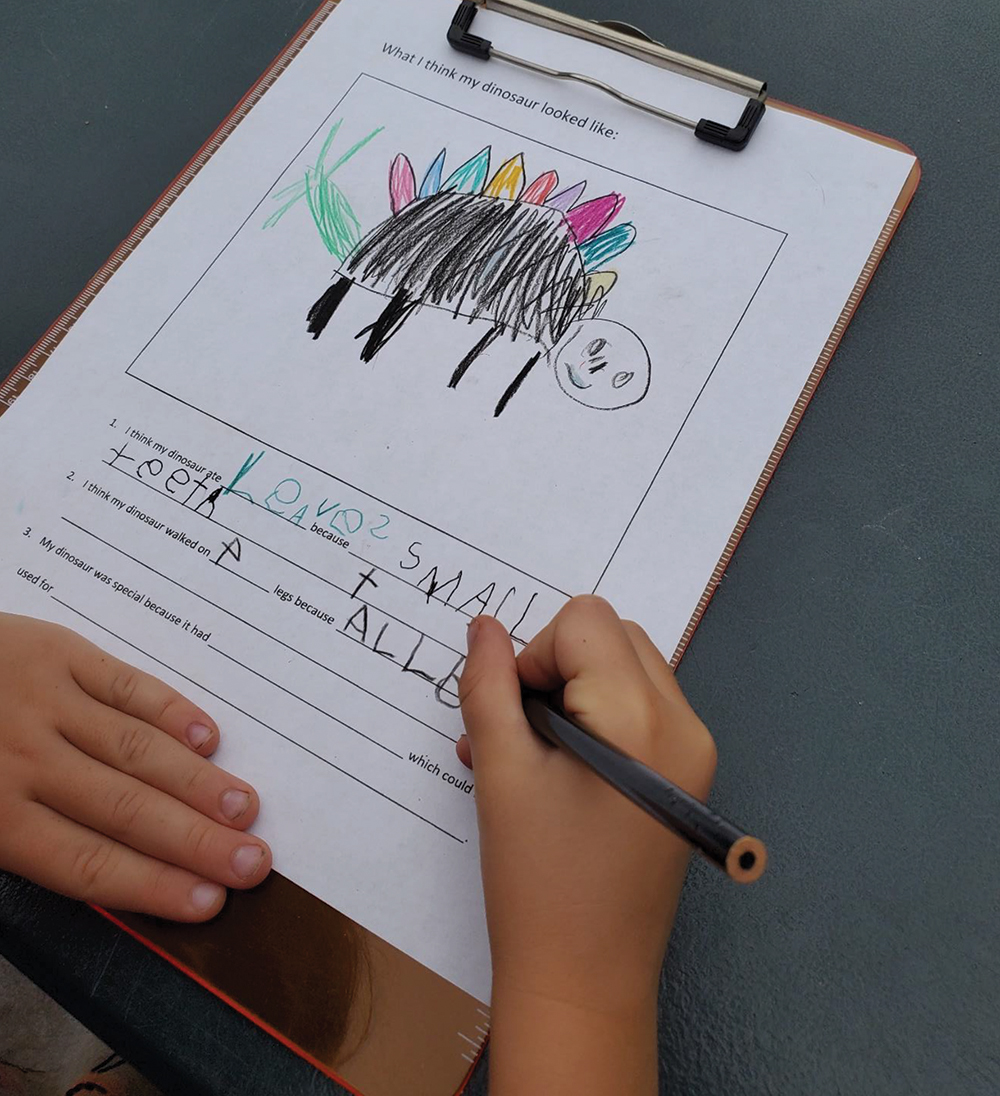
A student practices writing words while making inferences about her stegosaurus.
Evaluate
We brought the class into circle and had them share their understandings of paleontology. Students understood that paleontologists are a special type of scientist that studies old materials like fossils and uses tools to carefully excavate them. Students shared that bones, shells, and teeth could be fossils as well as things left behind by a plant or animal.
Each student got a chance to present their model drawings by holding up their drawing and showing the class. They explained why they thought their dinosaur looked how they drew it and what special features it had related to structure and function. This also gave students a chance to be the expert on their dinosaur and learn about the other two species that they did not examine. This also offered an opportunity for students to compare and contrast the three types of dinosaurs. Discussing findings was a way to start students in engaging in argument from evidence. Students got to practice listening “actively to arguments to indicate agreement or disagreement based on evidence, and/or to retell the main points of the argument” as well as to “construct an argument with evidence to support a claim” (NGSS Lead States 2013). They made arguments like “My T. rex had smaller arms so it walked on two feet like me, but the stegosaurus had four big feet and legs so it walked on four feet.” We asked students to raise hands and share if they agreed or disagreed with ideas presented by a classmate and explain their reasoning.
Concluding Remarks
This 5E lesson is an engaging way to introduce students to key science concepts like using evidence of common ancestry and diversity, structure and function, paleontology, and using evidence to back arguments. We feel that this is a great foray into modeling specifically since students worked to put plastic dinosaur models together and then created their own models. The ideas presented in the 5E lesson are formative concepts in science and therefore instruction could be spaced out over multiple days or a week.
Due to students’ continued interest, the boxes with kinetic sand, plastic fossils, and digging tools were kept out long-term so students could select to work with it for free-choice time since they were very enthusiastic about reburying and finding bones again. This became a favorite activity for months to come, with students shouting out which fossils bones they had just discovered and pretending to be paleontologists. Over time we continued to extend this activity with having students compare and contrast their dinosaur model bones with pictures in books of animals living today. They also enjoyed working collaboratively with a friend to put the skeletons back together. The continued interest in this lesson is why we believe it is a great way to introduce students to working with models and paleontology.
Resources
American Museum of Natural History: Dinosaurs
Norman, D., and A. Milner. 2004. Eyewitness books: Dinosaur. New York: D.K. Publishing.
Smith, M. 2011. Thomas the T. Rex, The journey of a young dinosaur to Los Angeles Young Readers Edition. Manhattan Beach, CA: East West Discoveries Press.
Laura B. Schneider (lbschneider@smcm.edu) is an adjunct professor in the Environmental Studies Program at St. Mary’s College of Maryland in St. Mary’s City, Maryland. Angelique Kelly is a primary-level teacher at Starmaker School for Early Education in California, Maryland.
5E Earth & Space Science Evolution Teaching Strategies Early Childhood


